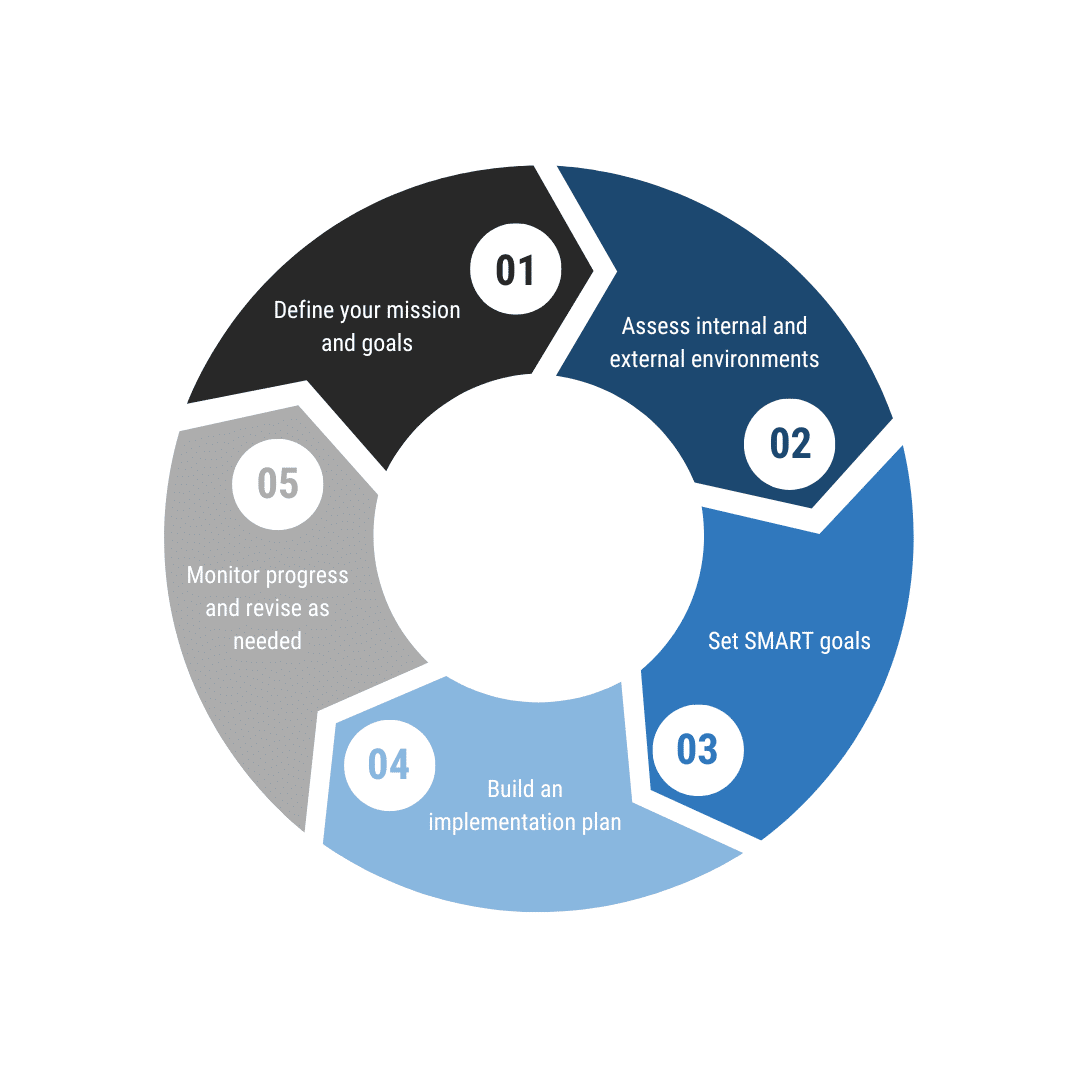Strategic planning in healthcare is essential for building strong, sustainable organizations regardless of size or setting. From tribal health departments to community clinics and outpatient behavioral health providers, every healthcare organization needs a clear direction to meet today’s complex challenges.
Without a strategic plan, it’s easy to get stuck reacting to daily demands instead of working toward long-term goals. Strategic planning in healthcare helps teams align their mission with measurable actions, allocate resources effectively, and respond confidently to seasonal shifts, staffing changes, and regulatory pressures.
In this Insight, we’ll walk through the basics of strategic planning in healthcare: what it is, why it matters, and how to create a plan that actually works. Whether you’re starting fresh or improving your current approach, this guide will help you move forward with purpose, clarity, and results.
Article Highlights
- Learn how to build a strategic plan that supports compliance, growth, and team alignment
- Understand how to prepare for seasonal fluctuations in healthcare demand
- Avoid common planning mistakes by applying a simple, proven framework
- 1. Article Highlights
- 2. What Is Strategic Planning in Healthcare?
- 3. Core Elements of Strategic Planning in Healthcare
- 4. What Strategic Planning in Healthcare Looks Like for Seasonal Shifts
- 5. Common Mistakes in Strategic Planning in Healthcare (and How to Avoid Them)
- 6. How Strategic Planning in Healthcare Supports Compliance and Growth
- 7. Building a Long-Term Strategy for Healthcare Leadership Success
- 8. Final Thoughts on Strategic Planning in Healthcare
- 9. Ready to Talk?
- 10. Further Reading
- 11. Related Articles
What Is Strategic Planning in Healthcare?
Strategic planning in healthcare is the process of setting clear goals, identifying priorities, and aligning resources to support the organization’s long-term vision. It helps healthcare leaders look beyond day-to-day operations and take a broader view of where the organization is headed, how it will get there, and what success looks like.
Unlike operational or compliance planning, which focuses on immediate tasks and regulatory requirements, strategic planning in healthcare is forward-thinking. It addresses big-picture questions about growth, quality, service delivery, and sustainability. It also provides a structured framework for making decisions, allocating funding, and measuring performance over time.
By building a solid strategic plan, healthcare organizations can stay focused, adapt to change, and lead with intention even during uncertain times.
Defining Strategic Planning in a Healthcare Context
At its core, strategic planning in healthcare means creating a roadmap that guides your organization toward specific goals. It begins with understanding where you are now, then outlining where you want to go and how you plan to get there. This includes setting priorities, developing timelines, assigning responsibilities, and tracking progress.
Strategic plans often cover areas like service expansion, workforce development, financial sustainability, community outreach, and regulatory readiness. They are designed to align leadership, departments, and teams under a unified mission while remaining flexible enough to adjust as needs evolve.
For additional guidance on the principles and structure of strategic healthcare planning, the American Hospital Association provides helpful strategic planning resources for healthcare leaders.
Why Strategic Planning in Healthcare Matters
Strategic planning is not just a paperwork exercise. It is a practical, essential process that helps healthcare organizations thrive in a challenging environment.
Here’s why it matters:
- It keeps teams focused on shared goals instead of reacting to daily fire drills
- It helps align budgeting, staffing, and operations with long-term priorities
- It prepares your organization to handle external pressures like policy changes, patient surges, and funding shifts
- It increases accountability across departments by clearly defining roles, metrics, and timelines
Healthcare is a fast-moving field. Strategic planning in healthcare gives organizations a sense of control, clarity, and momentum when it is needed most.
Core Elements of Strategic Planning in Healthcare
Strategic planning in healthcare works best when it follows a structured process. A strong plan doesn't need to be complicated, but it should include the essential building blocks that guide your organization toward clear, measurable outcomes. These core elements create a foundation for accountability, alignment, and adaptability.
Each part of the plan plays a specific role, from defining your purpose to measuring success over time. Below, we walk through the five key elements that every healthcare organization should include in their strategic planning process.
Aligning Vision and Mission in Strategic Planning
A strategic plan is only effective if it reflects your organization’s true mission and values. Before setting goals or selecting initiatives, it is important to revisit your core purpose and ask whether your current direction supports it.
Your mission defines why your organization exists. Your vision outlines what you aspire to achieve. Strategic planning in healthcare connects both to actionable goals, ensuring that day-to-day operations serve the bigger picture. This alignment gives staff and stakeholders clarity and motivation to move in the same direction.
Conducting an Environmental Assessment for Strategic Planning in Healthcare
A realistic plan starts with a clear view of your current environment. This assessment includes both internal and external factors that affect your organization.
Internally, consider your staffing, workflows, financial position, care quality, and infrastructure. Externally, evaluate community needs, policy changes, payer trends, and market shifts.
Conducting a formal assessment helps identify gaps and opportunities before you build your plan. For more on how to approach this step, see our Insight on Organizational & Operational Assessments, which outlines how we help leaders gather meaningful data to guide their strategy.
Goal Setting and Priorities in Strategic Planning
Once your vision is clear and your assessment is complete, it is time to define specific goals. Strategic planning in healthcare often fails when goals are too broad or unrealistic. We recommend using the SMART framework, which means goals should be Specific, Measurable, Achievable, Relevant, and Time-bound.
Some goals will focus on near-term wins, such as reducing no-show rates or improving billing turnaround. Others may look further ahead, such as expanding services or increasing community engagement. Prioritization is key. Choose what matters most based on your mission, resources, and readiness.
Creating an Implementation Framework for Strategic Planning in Healthcare
A plan is only valuable if it leads to action. That is why every strategic plan should include a clear implementation framework. This means outlining who is responsible for what, how progress will be tracked, and when milestones should be reached.
Assigning ownership across departments helps drive accountability. Setting realistic timelines keeps the plan moving forward. Building a communication plan ensures staff are informed, engaged, and empowered throughout the process.
Evaluating and Improving Your Strategic Planning Process
Finally, strategic planning in healthcare must include regular evaluation. This is how organizations learn, improve, and stay responsive to change.
Use performance metrics and KPIs to track progress toward each goal. Set review points quarterly or annually to assess what is working and what needs to shift. A good plan is a living document. The more you revisit and refine it, the more effective it becomes over time.
For more information on linking quality goals to performance, refer to the CMS Quality Strategy, which offers insights into aligning clinical care with measurable outcomes.

What Strategic Planning in Healthcare Looks Like for Seasonal Shifts
Every healthcare organization experiences predictable changes throughout the year. Patient volumes rise and fall. Staffing availability fluctuates. Community health needs shift based on weather, school schedules, and holidays. Strategic planning in healthcare should account for these seasonal patterns to ensure smooth operations and consistent quality of care.
By proactively planning for seasonal trends, organizations can reduce disruption, support staff more effectively, and meet patient needs with confidence. This section explores how to integrate seasonality into your strategic healthcare plan.
Understanding Seasonal Trends in Healthcare Demand
Seasonal fluctuations are not just a hospital concern. Outpatient clinics, behavioral health programs, and tribal health departments all experience cyclical changes that impact access, staffing, and patient flow.
For example:
- Winter months often bring higher demand for urgent care, respiratory services, and social support
- Summer may lead to reduced staff availability due to vacations or burnout
- The school calendar can influence adolescent mental health appointments and pediatric care
Strategic planning in healthcare should include time each year to review data trends related to seasonal demand. Use past years as a benchmark to anticipate what is ahead and prepare your teams accordingly.
Integrating Flexibility into Strategic Healthcare Plans
A good strategic plan does not just respond to change, it builds in the ability to flex. Healthcare leaders can strengthen seasonal planning by including strategies for resource reallocation, temporary program adjustments, and communication workflows that activate during peak times.
Examples include:
- Cross-training staff to fill high-need roles during seasonal surges
- Adding part-time or per-diem roles in anticipation of high-volume months
- Adjusting outreach and marketing strategies based on seasonal community needs
- Preparing supply chains for spikes in demand related to flu season or public health alerts
The key is to make seasonal readiness part of your strategic planning process, not an afterthought. By embedding flexibility into your annual goals and resource plans, your organization can operate with greater stability and resilience all year long.
For additional insight into seasonal preparedness, the CDC offers guidance on planning for health emergencies and seasonal surges that can be adapted for local or regional use.
Common Mistakes in Strategic Planning in Healthcare (and How to Avoid Them)
Even with the best intentions, many healthcare organizations struggle to get strategic planning right. Common missteps can stall progress, waste resources, and leave teams feeling disconnected from the bigger picture. Recognizing these pitfalls is an important part of building a more effective and lasting plan.
This section outlines key mistakes leaders often make during the strategic planning process and how to avoid them by focusing on clarity, inclusion, and follow-through.
Planning Without Data or Stakeholder Input
One of the most common mistakes in strategic planning in healthcare is building a plan based on assumptions rather than facts. Without current performance data or community insights, plans often miss the mark or focus on the wrong priorities.
Equally important is engaging the right voices early. Staff, patients, and community partners bring essential perspectives that can shape more grounded, actionable goals. When people feel included in the planning process, they are also more likely to support and follow through on the strategy.
Setting Vague or Unmeasurable Goals
A strategic plan that says “improve patient experience” or “enhance operations” lacks the clarity needed to drive action. Goals must be specific and measurable to move teams forward with purpose.
Strategic planning in healthcare works best when goals are clearly defined, tied to performance indicators, and tracked over time. Use SMART criteria to keep each objective focused and achievable. This helps departments understand their roles and creates a system for accountability.
Letting the Plan Sit on the Shelf
Another common issue is creating a strategic plan and then never using it. If the plan is not integrated into regular operations, budget decisions, and staff communication, it quickly loses relevance.
Successful healthcare organizations use their strategic plan as a living document. Leadership refers to it during quarterly reviews, team meetings, and decision-making. The more visible and usable the plan is, the more likely it is to create real outcomes.
Failing to Review and Update the Plan
Healthcare environments change quickly. Strategic planning in healthcare must include regular reviews to stay aligned with new challenges, opportunities, and data.
Set a calendar for plan reviews whether quarterly, mid-year, or annually, and invite key stakeholders to help assess progress. Update goals and action steps as needed. Continuous improvement ensures the plan stays active and relevant.
For organizations looking to strengthen their planning approach, our consulting team can help. See how John Lynch & Associates can help with your strategic planning.

How Strategic Planning in Healthcare Supports Compliance and Growth
Strategic planning in healthcare does more than guide internal goals. It also strengthens an organization’s ability to meet regulatory standards, improve care quality, and pursue meaningful growth. When a plan is built with intention and tied to measurable outcomes, it becomes a tool for compliance and long-term sustainability.
This section explores how a well-structured strategic plan supports both regulatory readiness and performance improvement while positioning your organization to expand and evolve with purpose.
Aligning Strategic Plans with Regulatory Requirements
Regulatory agencies expect healthcare organizations to operate with clear goals, policies, and accountability. Strategic planning in healthcare helps meet these expectations by creating a documented framework for leadership decisions, care quality targets, and process improvement.
Accrediting bodies such as the Centers for Medicare & Medicaid Services (CMS), The Joint Commission, and the Commission on Accreditation of Rehabilitation Facilities (CARF) often evaluate an organization’s planning process as part of their review. A well-documented strategy, backed by data and regular evaluation, demonstrates that your organization is intentional about compliance and quality.
Using Strategic Planning to Drive Quality and Performance
A good strategic plan goes beyond compliance. It sets the stage for improving outcomes, enhancing staff performance, and delivering higher-quality care. When your goals are tied to data, tracked consistently, and owned by cross-functional teams, real progress becomes possible.
Strategic planning in healthcare creates alignment across departments, allowing everyone to work toward shared quality benchmarks. This includes reducing readmission rates, improving patient satisfaction, and closing gaps in access or equity. Measurable goals also support data-driven decision-making, which is critical in today’s performance-based care environment.
Building Scalable, Sustainable Growth Through Strategy
Growth in healthcare should be thoughtful, not reactive. Strategic planning gives leaders the tools to identify where to invest, which services to expand, and how to build capacity without compromising care quality or compliance.
Whether your organization is preparing to pursue new funding, scale existing programs, or open new locations, strategic planning provides the structure and foresight to manage change effectively. It also helps you anticipate operational needs, regulatory risks, and staffing challenges that may emerge as you grow.
Building a Long-Term Strategy for Healthcare Leadership Success
Effective leadership requires more than day-to-day management. It takes vision, structure, and the ability to lead change over time. Strategic planning in healthcare gives leaders a clear pathway to guide their organizations with intention, especially when navigating complex challenges like regulatory shifts, workforce shortages, and evolving patient needs.
A long-term strategy allows healthcare leaders to think beyond immediate problems and shape a future that aligns with their organization’s mission and values. Whether you're leading a tribal health program, outpatient clinic, or behavioral health network, this kind of planning ensures leadership decisions are proactive, not reactive.
A Practical, Easy-to-Follow Framework for Strategic Planning in Healthcare
Creating a long-term strategy doesn’t have to be overwhelming. Below is a simple, five-step planning framework that healthcare leaders can use to build a solid foundation for strategic success:
This approach keeps your strategic plan flexible and functional while providing clarity for your leadership team and staff.
For help launching your next planning cycle, we invite you to connect with our team. Visit the Contact Us page at John Lynch & Associates to schedule a discovery session.
Final Thoughts on Strategic Planning in Healthcare
Strategic planning in healthcare is not just about producing a document. It is about creating a shared sense of purpose and direction that drives decisions, energizes teams, and supports long-term success.
No matter the size or scope of your organization, the most important step is simply to begin. Start with what you know. Involve your people. Focus on what matters most to your mission and your patients. A plan that is created with care, revisited regularly, and tied to real action can transform how your organization moves forward.
Progress matters more than perfection. Strategic planning in healthcare is most powerful when it is used, refined, and lived out through daily decisions. With the right framework and commitment, your plan can become the roadmap your organization needs to grow with purpose and deliver care that truly makes a difference.
Ready to Talk?
Further Reading
- Organizational & Operational Assessments – John Lynch & Associates
Learn how structured assessments can uncover performance gaps and guide stronger planning decisions. - Strategic Planning – John Lynch & Associates
Explore how a clear strategic roadmap can drive alignment, accountability, and long-term vision across your leadership team. - Contact Us – John Lynch & Associates
Ready to take the next step? Connect with our consulting team to schedule a discovery session and explore tailored planning support. - American Hospital Association – Strategic Planning Resources
Tools and guidance to support effective planning practices in healthcare organizations. - CMS – Quality Strategy
Learn how CMS defines quality and integrates strategic goals into care improvement. - CDC – Planning for Health Emergencies and Seasonal Surges
Frameworks and readiness tools to prepare for seasonal spikes in healthcare demand.
Related Articles

The Basics of Strategic Planning in Healthcare

Cultural Humility: The Underrated Competitive Advantage in Healthcare


